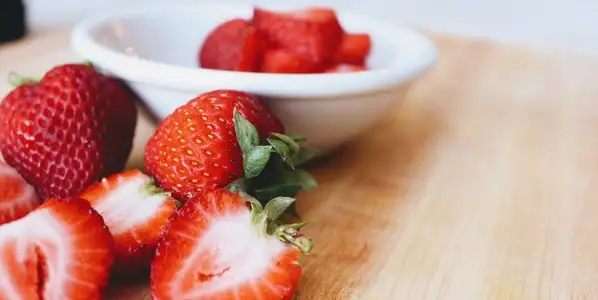
Whether fresh or frozen, there's no denying that strawberries are healthy.1. Why you should add more strawberries to your dietIf you're not already a fan of...
Read more


|
Nutrient |
Per 100 g | Per portion (130 g) |
|---|---|---|
|
Calorific value |
389 kJ | 505.7 kJ |
|
Energy |
93 kcal | 120.9 kcal |
|
Carbohydrates |
20 g | 26 g |
|
Protein |
1 g | 1.3 g |
|
Fat |
0 g | 0 g |
The food Banana (fresh) is composed of the following macronutrients.
Bananas have many health benefits. Here are some of them:
Bananas are tropical fruits grown in many parts of the world. They belong to the Musaceae family and are the largest and most widely consumed fruit in the world. Bananas are usually harvested green and ripen at room temperature. They have a yellow skin that sometimes has brown spots when fully ripe.
Bananas have a sweet flavor and a soft, floury texture. They can be eaten raw or cooked and are a popular ingredient in many baked goods such as cakes, pancakes and bread. Bananas are also commonly used in smoothies and granola bars.
There are several varieties of bananas that vary in size, color and flavor. Some of the most popular varieties are Cavendish, Gros Michel and Plantain.
What is the best way to store bananas to keep them fresh longer?
Bananas are best stored at room temperature, as they ripen faster when warm. If bananas are still green and not ripe enough to eat, they can be placed in paper or plastic bags to speed up the ripening process. If bananas are already ripe, they should be stored separately from other fruits, as they secrete ethylene, which can accelerate the ripening of other fruits.
How long does it normally take for bananas to ripen?
The ripening time of bananas depends on various factors such as variety, growing area and environmental conditions. However, it generally takes about 5-7 days for bananas to ripen when they are harvested green. When bananas turn yellow, they are ripe and can be eaten directly. However, some varieties may ripen faster or slower. Plantains, for example, usually take more time to ripen and may take weeks to reach full maturity. It is also important to note that the ripening time of bananas can also be affected by the way they are stored and transported, so it is important to store and transport bananas appropriately.
What is the difference between bananas and plantains?
Bananas and Plantains both belong to the same family (Musaceae), but there are some differences between them. Bananas are usually eaten raw and have a sweet flavor, while Plantains are usually boiled or fried and have a stronger flavor. Plantains are often used as a substitute for potatoes and are an important ingredient in many African and Latin American dishes. Bananas ripen faster than batatoes and are sweeter when fully ripe. Plantains ripen more slowly and are often not edible until they are fully brown and their skin hardens. Bananas have a soft and floury texture, while beans are harder and firmer. Bananas contain more sugar and less starch. In return, they contain more vitamin A and are richer in fiber. Plantains are grown in tropical areas such as Africa, South America and Southeast Asia, while bananas are grown worldwide. Bananas are often used in desserts and as a snack, while plantains are used as a side dish or ingredient in savory dishes.
How are bananas grown?
Growing bananas can be challenging because they are sensitive to various environmental conditions and pests. Bananas prefer a warm and humid climate. They are sensitive to frost and extreme temperatures and require plenty of water and moisture. Bananas require deep soils with adequate nutrients and drainage. They are fastidious about soil pH and require a pH of 6-7. Bananas are susceptible to a variety of pests and diseases including fungal diseases, pests such as the banana moth and the banana fly. Banana plants bear fruit only once and then need to be replaced. This requires regular maintenance and replanting of the plants. Bananas are often grown in monocultures, which can lead to problems such as soil erosion and loss of biodiversity. Bananas are grown in plantations, often in tropical areas. Plants are grown from cuttings and require a lot of care to protect them from pests and diseases and to ensure they receive adequate water and nutrients. Bananas are harvested when they are still green.
I love this app! The food is super varied and filling (and soo delicious!). With one purchase I have the ingredients for a whole week together, thanks to the shopping list. The ingredients are also readily available and not really expensive.
Nicole — App User
The first app in the field of nutrition tips that really convinces me. Updates get minor issues out of the way and new features are added all the time. Top!
Unknown user — App User
ave already tried many nutrition apps but here it is really great and you save a lot of time because you do not have to enter all the meals yourself! 👍👏
Mareen — App User
I don't usually rate apps but this one has to be rated.... I have never had such a great app just fits everything.... The nutrition plans are just absolutely awesome just everything is awesome many many thanks
Mareen — App User
This app is an excellent support for healthy eating even with little time and effort! Super recipes are also included. Highly recommended!
Lennert — App User